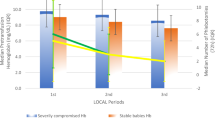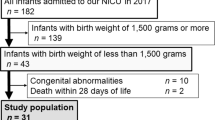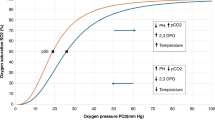Abstract
This study was made to determine the life span of adult red cells transfused to early preterm infants. Nineteen very preterm infants (birth weight, 878.7 ± 221 g; gestational age, 26.8 ± 1.5 wk at birth) were sampled weekly after their last blood transfusion to determine the level(%) of fetal Hb in their circulation. Two microliters of blood were subjected to reverse phase HPLC to separate the α, β, and γ globin components of their Hbs. The percent of fetal Hb (HbF) was calculated asγ/γ + β × 100. The life span of the adult erythrocytes transfused was defined as the time interval between the transfusion and when the percentage of HbF in the recipient's circulation returns to the HbF levels that exist in the infant's autologous red cells (the maximum post transfusion HbF level). Twelve of the 19 infants were followed until their autologus HbF levels were reached. Their mean adult red blood cell life span was 56.4± 7 d (range: 46-68 d). The results obtained in this study imply that the number of days after a transfusion at which half the cells infused remain in the circulation in a preterm infant is about 30 d.
Similar content being viewed by others
Log in or create a free account to read this content
Gain free access to this article, as well as selected content from this journal and more on nature.com
or
Abbreviations
- HbF:
-
fetal Hb
- HbA:
-
adult Hb
References
Strauss RG 1991 Transfusion therapy in neonates. Am J Dis Child 145: 904–911.
Mollisson PL 1983 Blood Transfusion in Clinical Medicine, 7th Ed. Blackwell Scientific Publications, Oxford, pp 93–110.
Mollison PL 1943 The survival of transfused erythrocytes in haemolytic disease of the newborn. Arch Dis Child 18: 161–171.
Mollison PL 1948 Physiological jaundice of the newborn. Lancet April 3: 513–515.
Ashby W 1919 The determination of the length of life of transfused blood corpuscles in man. J Exp Med 29: 267–281.
Mollison PL, Young IM 1940 Survival of the transfused erythrocytes of stored blood. Lancet Oct 5: 420–421.
Pearson HA 1967 Life-span of the fetal red blood cell. J Pediatr 70: 166–171.
Bratteby L-E, Garby L, Wadman B 1968 Studies on erythro-kinetics in infancy. XII. Survival in adult recipients of cord blood red cells labelled in vitro with Di-isopropyl fluorophosphonate(DF32P). Acta Paediatr Scand 57: 305–310.
Bard H, Makowski EL, Meschia G, Battaglia FC 1970 The relative rates of synthesis of hemoglobins A and F in immature red cells of newborn infants. Pediatrics 45: 766–772.
Brown MS 1973 Physiologic anemia of infancy: normal red-cell values and physiology of neonatal erythropoiesis. In: Stockman III JA, Pochedly C (eds) Developmental and Neonatal Hematology. Raven Press, New York, pp 249–274.
Bard H 1973 Postnatal fetal and adult hemoglobin synthesis in early preterm newborn infants. J Clin Invest 52: 1789–1795.
Bard H, Widness JA 1995 Effect of recombinant human erythropoietin on the switchover from fetal to adult hemoglobin synthesis in preterm infants. J Pediatr 127: 478–480.
Bechensteen AG, Refsum HE, Halvorsen S, Hågå S P, Liestøl K 1995 Effects of recombinant human erythropoietin on fetal and adult hemoglobin in preterm infants. Pediatr Res 38: 729–732.
Bard H, Widness JA, Ziegler EE, Gagnon C, Peri KG 1995 The proportions of Gγ- and Aγ-globins in the fetal hemoglobin synthesized in preterm and term infants. Pediatr Res 37: 361–364.
Stockman JA III 1988 Physical properties of the neonatal red blood cell. In: Stockmann III JA, Pochedly C (eds) Developmental and Neonatal Hematology. Raven Press, New York, pp 297–323.
Vácha J, Znohl V 1981 The allometric dependence of the life span of erythrocytes on body weight in mammals. Comp Biochem Physiol 69A: 357–362.
Acknowledgements
The authors thank the research nurses, including Karen J. Johnson, R.N., and June E. Miller, R.N., who helped in the study.
Author information
Authors and Affiliations
Additional information
Supported by grants from the Medical Research Council of Canada MT-11552(H.B.) and the National Institute of Health P01 HL46925 and GCRC RR0059(J.A.W.).
Presented in part at the Annual Meeting of the Society for Pediatric Research and the American Pediatric Society, San Diego, CA, May 9, 1995.
Rights and permissions
About this article
Cite this article
Bard, H., Widness, J. The Life Span of Erythrocytes Transfused to Preterm Infants. Pediatr Res 42, 9–11 (1997). https://doi.org/10.1203/00006450-199707000-00002
Received:
Accepted:
Issue date:
DOI: https://doi.org/10.1203/00006450-199707000-00002
This article is cited by
-
Hyperferritinemia among very-low-birthweight infants in Thailand: a prospective cohort study
Journal of Perinatology (2023)
-
The role of zinc protoporphyrin measurement in the differentiation between primary myelofibrosis and essential thrombocythaemia
Annals of Hematology (2011)
-
Iron supplementation for preterm infants receiving restrictive red blood cell transfusions: reassessment of practice safety
Journal of Perinatology (2010)
-
Zinc protoporphyrin, a useful parameter to address hyperferritinemia
Annals of Hematology (2007)



